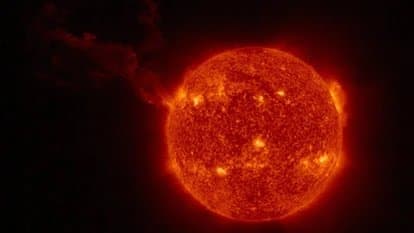
Massive solar eruption caught on camera
A massive solar eruption, which took place on February 15, 2022 and extended for millions of miles into space, has been caught on camera by the European Space Agency’s (ESA) Solar Orbiter probe, a spacecraft loaded with ten highly proficient telescopes and direct sensing instruments. According to ESA, this is the largest solar prominence eruption ever observed in a single image with the full solar disc in shot.
Solar prominences are large structures of tangled magnetic field lines which maintain dense concentrations of solar plasma suspended above the Sun’s surface, sometimes taking the shape of arching loops. They are often associated with coronal mass ejections or bursts of radiation which, if directed towards the Earth, can significantly interfere with our technological devices and daily lives. Fortunately, this time the radiation burst was not directed towards our planet, since it erupted from the opposite side of the Sun.
The eruption was filmed by state-of-the-art cameras located on ESA’s Solar Orbiter spacecraft. According to ESA, the “Solar Orbiter is the most complex scientific laboratory ever to have been sent to the Sun.” It was launched from Cape Canaveral, Florida in February 2020 in order to capture images of the Sun from closer than any spacecraft before. By flying within 26 million miles of the Sun’s surface, the Solar Orbiter is an invaluable tool for inspecting the star’s poles and for recording and investigating the Sun’s more violent outbursts, such as this latest eruption.
“Although our life-giving star has been an object of scientific interest for centuries, its behavior still presents a puzzle for scientists,” the ESA wrote.
“By combining observations from Solar Orbiter’s six remote-sensing instruments and four sets of in situ instruments, scientists hope to find answers to some profound questions: What drives the Sun’s 11-year cycle of rising and subsiding magnetic activity? What heats up the upper layer of its atmosphere, the corona, to millions of degrees Celsius? What drives the generation of the solar wind? What accelerates the solar wind to speeds of hundreds of kilometers per second? And how does it all affect our planet?”
The Solar Orbiter will work closely with NASA’s Parker Solar Probe – which was launched in August 2018 and is also studying the Sun’s corona – to reveal what triggers solar storms, in order to manage to better predict them in the future. While the latest solar eruption didn’t send a burst of deadly radiation towards the Earth, it is an important reminder of the unpredictable nature of the Sun and the importance of understanding and monitoring its behavior.
Image Credit: ESA/NASA Solar Orbiter team
—
By Andrei Ionescu, Earth.com Staff Writer












